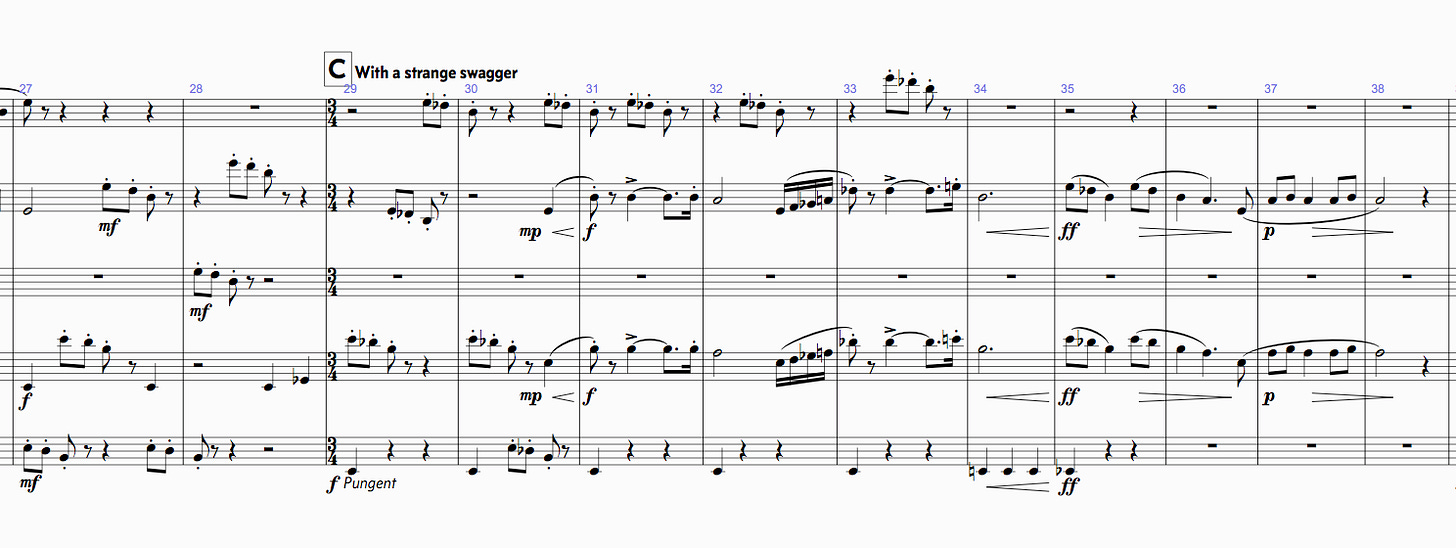Applying Critical Feedback
One of my compositions wasn’t selected in a recent competition, but I got the next best thing: detailed and actionable feedback about my music from a group of professional musicians
A few months ago, I submitted a recently composed reed quintet to a composition competition. Though my piece didn’t win, I got the next best thing: detailed and actionable feedback about my music from a group of professional musicians.
So far having had just a few opportunities to have my music performed or rehearsed, I’m always interested to hear what kind of impression my music makes on other performers; ultimately I want to write things that are fun to play and a joy to listen to. So here I will discuss their feedback and how I’m working to incorporate it within the context of what I’m trying to do musically/expressively.
My submission
I submitted the outer movements of a four-movement piece for reed quintet called After Hours and received feedback on both of them. For this post, I’m going to focus on the first movement Wayfarer. From the program notes:
I. Wayfarer pays homage to the sci-fi book series of the same name. I like to think the music and the universe that queer PNW author Becky Chambers conjures share a lot—warmth, energy, emotional intelligence, hopefulness, with much to teach us about accepting people and beings that might at first unsettle us. (Chambers’ books are much better than my music, so please check them out!)
To say a bit more about the character and shape of the music, the movement is in ABA form (with a very short introduction); the outer sections have an energetic, sparkling, exploratory, almost Star Trekkian feel which frames a middle section which could be an encounter with a strange and initially frightening/off-putting culture or species. For context, you can listen to the full first movement as submitted (and the rest of the piece below):
The feedback
Your piece certainly had positive elements. Good energy, nice groove, clear parts.
Reasons as to why it didn’t proceed:
Mvt 1 passage C to H are on the simplistic side. (Simplicity can be enchanting, but apparently it didn’t do that for us here)
Mvt 4 although it starts very strong with a great groove, again it has – this time harmonically – less convincing moments (C to D)
Two general remarks could be:
Register - that the registers of the instruments are being used in a somewhat ’safe’ way, and the bass side of the group could be used more. The lower part of the ensemble is used sparsely, and almost never by the two bass instruments at the same time.
Harmony - if there is a lot homo-rhythmic stuff happening, like there is, it might be good to try to be harmonically (or melodically) somewhat more daring / spicy.
So the judges found the frame of the first movement to be compelling enough, but the central section lacked a sophistication or interesting simplicity. Lucky for me, the judges were also kind enough to offer some prescriptions for what ails my music—shifting the balance of the registers toward more frequent use of the lower voices and balancing simplicity in one component of the music with complexity or interest in another.
How to take this feedback on board and apply it?
To figure out how to apply the feedback, we need to add one more ingredient: what the music needs to be doing expressively, or at least what I would like the music to be doing. To come up with a solution that is perhaps more satisfying to performers and listeners while still meeting the expressive needs of the music is the key. Does such an intersection exist here?
And what was I trying to do with the music?
I wanted this part of the music to represent a moment of being dropped into a strange and uncomfortable situation and trying to make do—perhaps two beings or cultures that don’t understand each other and may even be initially repulsed but are trying in good faith to find a rhythm and rapport.
So, how can increased use of the lower voices and adding more interesting musical elements/texture support that expressive goal?
Some ideas
First I’m going to try experimenting with the accompanying parts, since it is often the background musical material that sets the mood for the main character. Throughout this section the melody is something that is gradually explored and eventually unveiled to be the lyrical thing that it is, so I don’t want to change it too much to avoid disrupting that progression.
Additionally, there are motivic relationships between the melody and other sections that I don’t want to consider upsetting just yet. So I will focus my attention on the accompaniment for now.
One way the accompaniment of my first version doesn’t support the strange/uncomfortable/repulsive paradigm is that it is pretty regular and stays mostly in the background when it could interact more with the melodic material and creating a sense of instability about what the listener should be focused on.
So let’s experiment with creating a more active background that is also a little less predictable and sometimes embellishes, sometimes grates against the melody. Here’s the new accompaniment:
It’s more propulsive and maybe just a touch more intense than I was looking for, but let’s see how it plays with the melody:
I like where it’s headed. Let’s try applying the same ideas (a more active and unsettled/unpredictable accompaniment) to the rest of this section and look for places where we can thicken the lower register through doublings and additional counter lines:
This section now definitely has more character, energy, and dynamism than in the first version, but I still feel the need to tinker to bring back some of the odd-but-noble character the music used to have. I’m looking forward to sharing where this process of revision goes!
See other changes I’ve made to this piece here.






